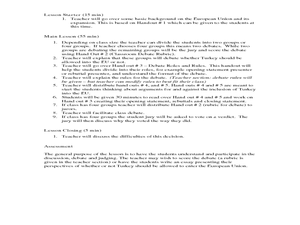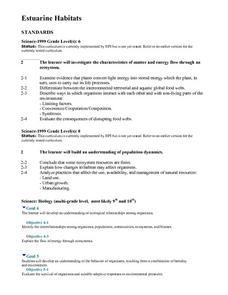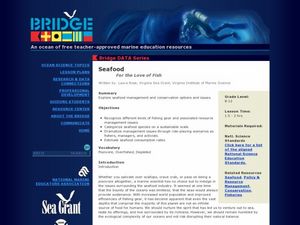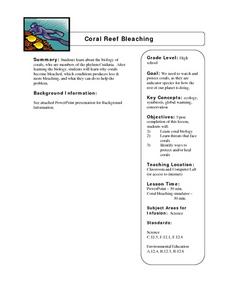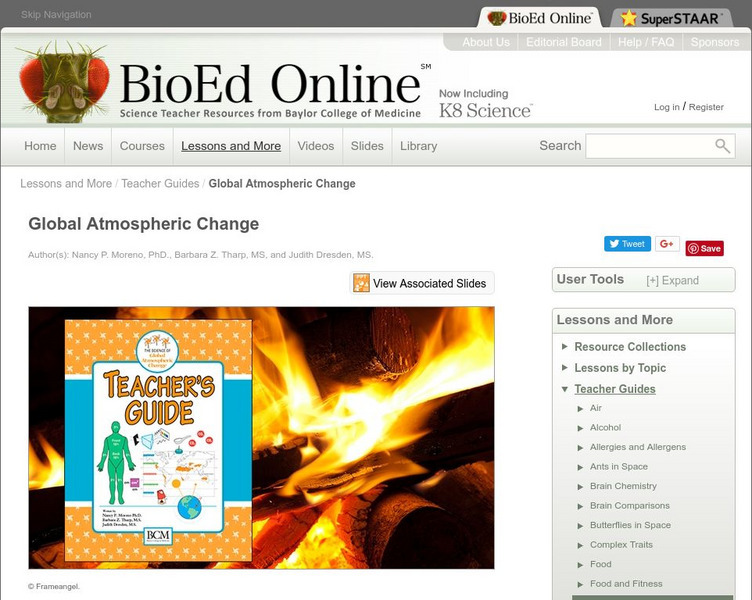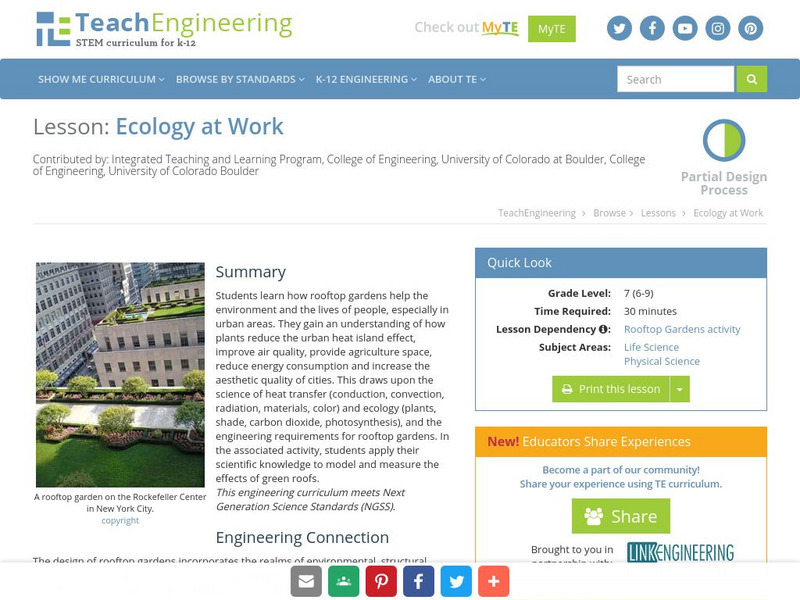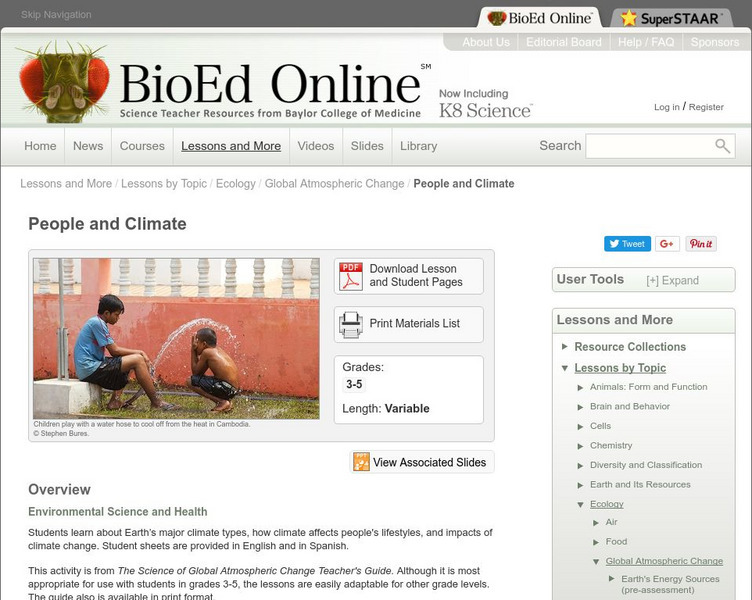Curated OER
Earth Water Distribution and Water Consumption
Young scholars explore the need for conserving fresh water and understand that it is a limited supply. In this water consumption lesson students participate in an activity and answer questions.
Curated OER
Who is Allowed into the EU?
Twelfth graders investigate whether Turkey will join the European Union. In this government structures lesson, 12th graders prepare for and participate in a debate over expansion within the European Union.
Curated OER
Radical Raptors
Students study the lifestyles and habitats of raptors that live in Minnesota. They play games associated with their study.
Curated OER
How Much Is An Ecosystem Worth?
Students explain and discuss the importance of ecosystems. They analyze the natural resources in the environment. They also suggest actions that would protect ecosystems.
Curated OER
Canada...a Visual Journey
Learners, in groups, research Canada's six natural regions (ecozones). They create a visual representation of each region on a large wall map of Canada and present it to the rest of the class.
Curated OER
Genetic Disorders with Cultural Roots: International Insects
Students recognize that certain populations have specific genetic disorders that could benefit or harm them in their environment, work out punnett square problems and infer offspring probabilities from results, and provide advantages and...
Curated OER
Canada...A Visual Journey
Students work together to analyze the six natural regions of Canada. Using this information, they create a visual representation of each region on a large wall map and present it to the class. They must identify five key points of each...
Curated OER
Science Italian Style: Eruption!
Students explore ways scientists prepare for a volcanic eruption. They observe films of earthquakes, oil spills, volcanoes and hurricanes. Students perform activities to demonstrate the relationship of viscosity to lava flow. They...
Curated OER
Flowering Phenology: How Do Plants Know When to Flower?
Young scholars study the process of plant reproduction and the biotic and abiotic factors that affect flowering phenology. In this plant reproduction lesson, students describe the interaction of environmental factors as it relates to...
Curated OER
Microbes and Climate
Students examine how microbes play a role in the climate system. In this climate lesson students complete an activity, create a PowerPoint presentation and present it to the class.
Curated OER
Predators Among Us
Students study environmental science. In this ecosystems lesson, students discover how humans have an impact on life in the coral reef. They watch video clips and work on small group activities. This lesson includes links to the videos...
Curated OER
Rain Forests: Sustainable Use
Students discuss their opinion on a teacher given scenario. In this chemistry lesson, students research the value of rainforests. They relate these ideas to current forestry practices.
Curated OER
Terrestrial Ecozones, Population Density and Species at Risk
Tenth graders navigate and use the online Atlas of Canada. They explain the cause and effect relationship between human settlement and the natural environment and wildlife species. They utilize a worksheet imbedded in this plan.
Curated OER
The Arctic and Taiga Ecozone of Canada
Students discover the differences in the Arctic and Taiga regions of Canada. They identify physical and human characteristics of both region. They also practice using an atlas.
Curated OER
Estuarine Habitats
Sixth graders study the important habitats, flora, fauna, and physical factors of coastal habitats. They compare the aquatic habitats to terrestrial habitats by researching and completing tables with the information.
Curated OER
Primary Producers
Students examine the role of carbon in the oceans and how phytoplankton determine the levels present. In groups, they practice measuring primary productivity using two methods. They use the internet to research the role of phytoplankton...
Curated OER
The Arctic and Taiga Ecozone of Canada
Young scholars examine the various sub-regions of the Arctic and Taiga zones in Canada. Using the online Canadian Atlas, they locate and describe the characteristics of each zone. They organize their information into a chart and share...
Curated OER
Snow on Sea Ice
High schoolers examine different samples of ice and predict the amount of snow that has fallen in a given year. Using a calculator, they graph the various thicknesses. They analyze the graphs to determine the relationship between the...
Curated OER
Seafood: For the Love of Fish
Students role play a scenario specific to decision making in seafood management and conservation. In this marine science lesson, students estimate seafood consumption in their state. They recommend new regulations for better fishery...
Curated OER
Coral Reef Bleaching
Students explore the structural biology of corals. Working individually, students identify how corals become bleached and which conditions produce more and less coral bleaching. Students explore how this effects the environment and...
BioEd Online
Bio Ed Online: Global Atmospheric Change
A teaching guide with eleven lessons on the atmosphere, and the impact that different kinds of energy have on the atmosphere and ecological systems. The unit and accompanying PowerPoint can both be downloaded.
TeachEngineering
Teach Engineering: Ecology at Work
Students learn how rooftop gardens help the environment and the lives of people, especially in urban areas. They gain an understanding of how plants reduce the urban heat island effect, improve air quality, provide agriculture space,...
Tramline
Tramline: Getting Green Virtual Field Trip
In this comprehensive website, students will learn about different forms of pollution, environmental impact of pollution, global warming, and things they can do to make a difference.
BioEd Online
Bio Ed Online: The Science of Global Atmospheric Change: People and Climate
The impact that climate and climate change have on humans is explored in this lesson. Students learn about climate zones, and factors that affect climate, e.g., proximity to the ocean and greenhouse gases. The lesson and accompanying...

